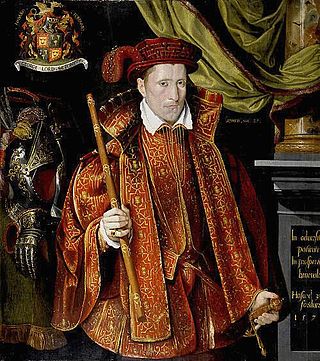Related Research Articles

Alexander Seton, 1st Earl of Dunfermline (1555–1622) was a Scottish lawyer, judge and politician. He served as Lord President of the Court of Session from 1598 to 1604, Lord Chancellor of Scotland from 1604 to 1622 and as a Lord High Commissioner to the Parliament of Scotland.

Halidon Hill is a summit, about 2 miles (3 km) west of the centre of Berwick-upon-Tweed, on the border of England and Scotland. It reaches 600 feet (180 m) high. The name of the hill indicates that it once had a fortification on its top. It is bounded by the A6105 road on its south and the A1 road to the northeast.

The Treaty of Berwick was negotiated on 27 February 1560 at Berwick-upon-Tweed. It was an agreement made by the representative of Queen Elizabeth I of England, the Duke of Norfolk, and the group of Scottish nobles known as the Scottish Lords of the Congregation. The purpose was to agree the terms under which an English fleet and army would come to Scotland to expel the French troops who were defending the Regency of Mary of Guise. The Lords were trying both to expel the French and to effect the Scottish Reformation, and this led to rioting and armed conflict.
Simon Basil was an English surveyor or architect, who held the post of Surveyor of the King's Works, 1606-15.
John Carey, 3rd Baron Hunsdon was an English peer, politician and Governor of Berwick-upon-Tweed.
Henry Atkins (1558–1635) was an English physician.

George Seton V, 7th Lord Seton (1531–1586), was a Lord of the Parliament of Scotland, Master of the Household of Mary, Queen of Scots, and Provost of Edinburgh. He was the eldest son of George Seton, 6th Lord Seton, and Elizabeth Hay, a daughter of John Hay, 3rd Lord Hay of Yester. His childhood and schooling were in France.

Edmund Ashfield was an English Catholic from Tattenhoe in Buckinghamshire. In 1599 he travelled to Edinburgh to meet James VI of Scotland. An English diplomat organised his kidnap and rendition in the belief that Ashfield was an agent of James VI and working to further his succession to the English throne.
Sir William Bowes of Streatlam,, was an English ambassador to Scotland, Deputy Warden of the West March, Treasurer of Berwick-upon-Tweed, and Member of Parliament for Westmorland.

Thomas Fowler was an English lawyer, diplomat, courtier, spy, servant of the Countess of Lennox, broker of the marriage of Mary, Queen of Scots and Lord Darnley, steward of the Earl of Leicester, advisor to James VI of Scotland and the Scottish ambassador in London, Archibald Douglas.

Wark on Tweed Castle, sometimes referred to as Carham Castle, is a ruined motte-and-bailey castle at the West end of Wark on Tweed in Northumberland. The ruins are a Grade II* listed building.

Frances Howard, Countess of Kildare, was a courtier and governess of Princess Elizabeth Stuart, Queen of Bohemia, and a member of the House of Howard.
Barbara Ruthven was a Scottish courtier and favourite of Anne of Denmark, expelled from court after the death of her brother.
William Selby, was an English member of parliament and soldier at Berwick upon Tweed.
Sir Francis Gofton was an English courtier and administrator. He was an auditor of royal accounts and jewels, Chief Auditor of the Imprest from 1597 and Auditor of Mint from August 1603. Gofton acquired the manor of Heathrow, and houses in Stockwell and West Ham. He was often called "Auditor Gofton". The surname is frequently transcribed as "Goston" or "Guston"
George Nicholson or Nicolson, was an English diplomat in Scotland.
Nicolas Errington was an English soldier, military engineer, and administrator.
Robert Wroth was an English courtier and Member of Parliament for Newtown.

Nicholas Williamson was an English lawyer and Catholic recusant in the 1590s. He was arrested in 1595 after planning a visit to the court of James VI of Scotland. The Jesuit William Crichton had hoped that Williamson would encourage the ambition of James VI for the throne of England.
William Bowyer was an English soldier, administrator, and Captain of the garrison at Berwick-upon-Tweed.
References
- ↑ HMC Salisbury Hatfield, vol. 4 (London, 1892), p. 487.
- ↑ Howard Colvin, History of the King's Works, 1485-1660, part 2 (London, 1963), p. 694: Mary Anne Everett Green, Calendar State Papers Domestic, Addenda, 1580-1625 (London, 1872), p. 326.
- ↑ William Murdin, Collection of State Papers (London, 1759), p. 803.
- ↑ William Acres, Letters of Lord Burleigh to his son Robert Cecil (Cambridge, 2017), pp. 116-7: HMC Salisbury Hatfield, vol. 4 (London, 1892), pp. 470, 487, 511.
- ↑ Joseph Bain, Border Papers, vol. 1 (London, 1894), pp. 529-30, 535-6.
- ↑ Joseph Bain, Border Papers, vol. 2 (London, 1896), pp. 34 no. 71, 61 no. 137, 172 no. 337.
- ↑ John Scott, Berwick-upon-Tweed: The History of the Town and Guild (London, 1888), p. 190.
- ↑ Calendar State Papers Domestic, Addenda, 1580-1625 (London, 1872), p. 438.
- ↑ George Seton, Memoir of Alexander Seton (Edinburgh, 1882), pp. 58-60.
- ↑ William Kelly, Royal Progresses and Visits to Leicester (Leicester, 1884), pp. 328-331.
- ↑ Walter Seton, 'Early Years of Henry Frederick, Prince of Wales, and Charles, Duke of Albany', Scottish Historical Review, 13:52 (July 1916), pp. 373-4.
- ↑ Frederick Devon, Issues of the Exchequer (London, 1836), pp. 14-5.
- ↑ Mary Anne Everett Green, Calendar of State Papers Domestic: James I, 1603–1610 (London, 1857), pp. 56 no. 5, 67 no. 11.
- ↑ HMC Salisbury Hatfield, vol. 23 (London, 1973), p. 177.
- ↑ Edwin Dodds, Registers of Berwick-upon-Tweed, in the county of Northumberland: Baptisms, vol. 1 (Newcastle, 1905).
- ↑ L. C. Martin, 'John Crane (1576–1660) OF Loughton, Bucks', The Mariner's Mirror, 70:2 (1984), pp. 143-8.
- ↑ Joseph Howard & William Hart, The Cranes of Suffolk, extracted from The Visitation of Suffolke (Lowestoft, 1865), p. 3: Thomas Pennant, History of the Parishes of Whiteford and Holywell (London, 1796), p. 45.